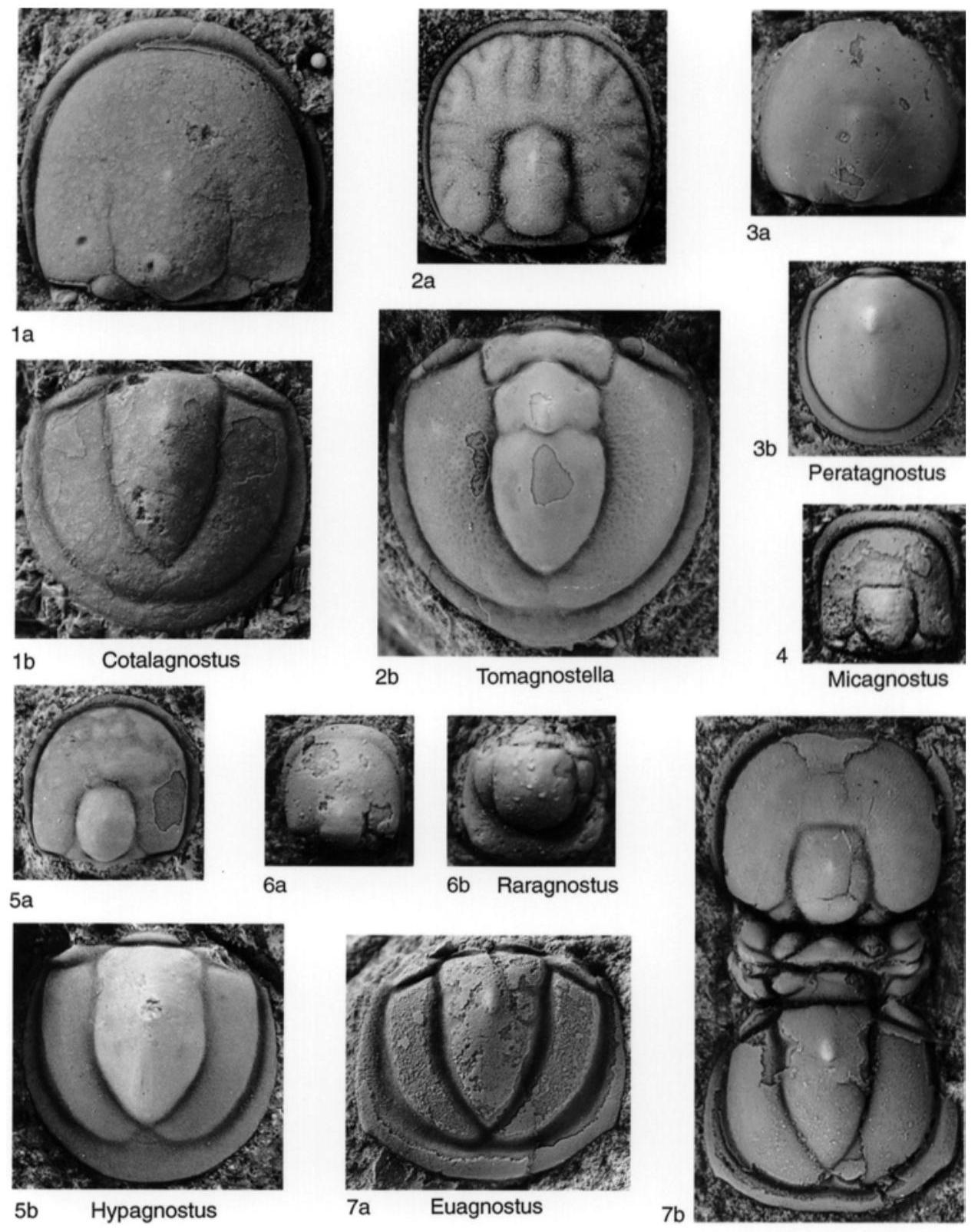Welcome to the Treatise on Invertebrate Paleontology!
Please enter a genera name to retrieve more information.

Tomagnostella
Classification
Phylum:
Arthropoda
Class:
Trilobita
Order:
Agnostida
Superfamily:
Agnostoidea
Family:
Spinagnostidae
Formal Genus Name and Reference:
Tomagnostella KOBAYASHI, 1939a, p. 150
Type Species:
Agnostus exsculptus Angelin, 1851, p. 7, OD, lectotype (Tullberg, 1880, pl. 1, fig. 10, SD WestergÅd, 1946, p. 118), Ar 2007, RM, Stockholm
Images
(Click to enlarge in a new window)
Fig. 226,2a. *T. exsculpta (A NGELIN ), upper Middle Cambrian (S. brachymetopa Zone), Sweden (Andrarum Limestone, Andrarum, Skåne); lectotype, cephalon, RM Ar 2007, ×10 (new).——Fig. 226,2b. T. sulcifer (WALLERIUS), upper Middle Cambrian (Lejopyge laevigata Zone), Sweden (Gudhem, Västergötland); topotype, pygidium, SGU 4807, ×9 (new).
Synonyms
Geographic Distribution
northern Greenland; Sweden, H. parvifrons to L. laevigata Zones; Norway, England, L. laevigata Zone; Russia (Siberia), northern Turkestan Mountain Range, late P. davidis to L. laevigata Zones; Canada (Northwest Territories), Cedaria minor Zone; Australia (Queensland), G. nathorsti Zone; China (Zhejiang), G. stolidotus Zone, (Hunan, Guizhou), upper Middle Cambrian.
Age Range
Beginning Stage in Treatise Usage:
Middle Cambrian
Beginning International Stage:
Cambrian Stage 4
Fraction Up In Beginning Stage:
40
Beginning Date:
512.3
Ending Stage in Treatise Usage:
lower Upper Cambrian
Ending International Stage:
Jiangshanian
Fraction Up In Ending Stage:
25
Ending Date:
493.4
Description
Commonly weakly scrobiculate, median preglabellar furrow occasionally weakly developed, usually absent. Glabella with F3 straight, bent forward, chevronate or rarely effaced, posterior lobe with F2 commonly developed, glabellar node from slightly behind to slightly in front of F2 furrows. Pygidial axis long, commonly reaching border furrow or connected to it by median postaxial furrow, usually strongly constricted across M2, F1 clearly developed, bent forward, F2 variably developed, nearly straight, with a slight median deflection around axial node.
References
Museum or Author Information
Classification
Phylum:
Arthropoda
Class:
Trilobita
Order:
Agnostida
Superfamily:
Agnostoidea
Family:
Spinagnostidae
Formal Genus Name and Reference:
Tomagnostella KOBAYASHI, 1939a, p. 150
Type Species:
Agnostus exsculptus Angelin, 1851, p. 7, OD, lectotype (Tullberg, 1880, pl. 1, fig. 10, SD WestergÅd, 1946, p. 118), Ar 2007, RM, Stockholm
Images
(Click to enlarge in a new window)
Fig. 226,2a. *T. exsculpta (A NGELIN ), upper Middle Cambrian (S. brachymetopa Zone), Sweden (Andrarum Limestone, Andrarum, Skåne); lectotype, cephalon, RM Ar 2007, ×10 (new).——Fig. 226,2b. T. sulcifer (WALLERIUS), upper Middle Cambrian (Lejopyge laevigata Zone), Sweden (Gudhem, Västergötland); topotype, pygidium, SGU 4807, ×9 (new).
Synonyms
Geographic Distribution
northern Greenland; Sweden, H. parvifrons to L. laevigata Zones; Norway, England, L. laevigata Zone; Russia (Siberia), northern Turkestan Mountain Range, late P. davidis to L. laevigata Zones; Canada (Northwest Territories), Cedaria minor Zone; Australia (Queensland), G. nathorsti Zone; China (Zhejiang), G. stolidotus Zone, (Hunan, Guizhou), upper Middle Cambrian.
Age Range
Beginning Stage in Treatise Usage:
Middle Cambrian
Beginning International Stage:
Cambrian Stage 4
Fraction Up In Beginning Stage:
40
Beginning Date:
512.3
Ending Stage in Treatise Usage:
lower Upper Cambrian
Ending International Stage:
Jiangshanian
Fraction Up In Ending Stage:
25
Ending Date:
493.4
Description
Commonly weakly scrobiculate, median preglabellar furrow occasionally weakly developed, usually absent. Glabella with F3 straight, bent forward, chevronate or rarely effaced, posterior lobe with F2 commonly developed, glabellar node from slightly behind to slightly in front of F2 furrows. Pygidial axis long, commonly reaching border furrow or connected to it by median postaxial furrow, usually strongly constricted across M2, F1 clearly developed, bent forward, F2 variably developed, nearly straight, with a slight median deflection around axial node.
